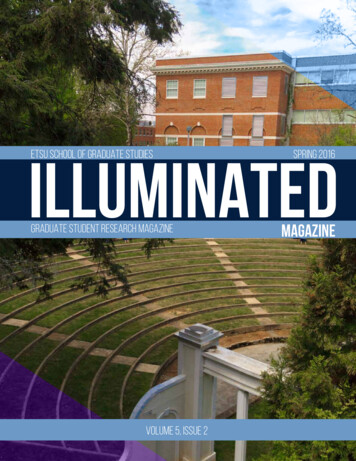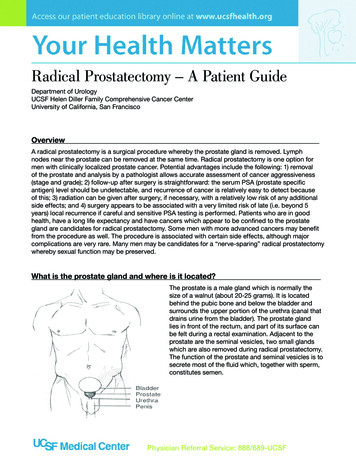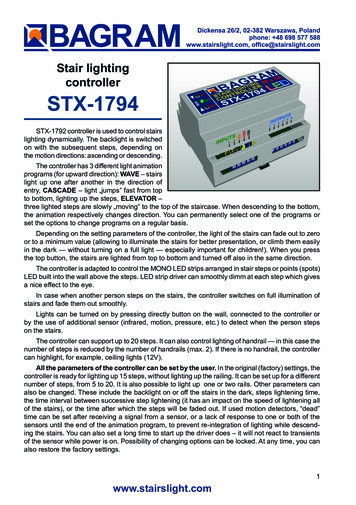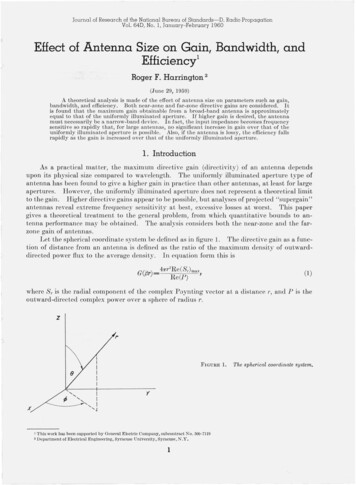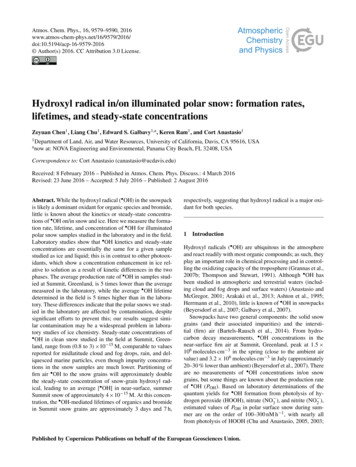
Transcription
Atmos. Chem. Phys., 16, 9579–9590, 94/acp-16-9579-2016 Author(s) 2016. CC Attribution 3.0 License.Hydroxyl radical in/on illuminated polar snow: formation rates,lifetimes, and steady-state concentrationsZeyuan Chen1 , Liang Chu1 , Edward S. Galbavy1,a , Keren Ram1 , and Cort Anastasio11 Departmenta nowof Land, Air, and Water Resources, University of California, Davis, CA 95616, USAat: NOVA Engineering and Environmental, Panama City Beach, FL 32408, USACorrespondence to: Cort Anastasio (canastasio@ucdavis.edu)Received: 8 February 2016 – Published in Atmos. Chem. Phys. Discuss.: 4 March 2016Revised: 23 June 2016 – Accepted: 5 July 2016 – Published: 2 August 2016Abstract. While the hydroxyl radical ( OH) in the snowpackis likely a dominant oxidant for organic species and bromide,little is known about the kinetics or steady-state concentrations of OH on/in snow and ice. Here we measure the formation rate, lifetime, and concentration of OH for illuminatedpolar snow samples studied in the laboratory and in the field.Laboratory studies show that OH kinetics and steady-stateconcentrations are essentially the same for a given samplestudied as ice and liquid; this is in contrast to other photooxidants, which show a concentration enhancement in ice relative to solution as a result of kinetic differences in the twophases. The average production rate of OH in samples studied at Summit, Greenland, is 5 times lower than the averagemeasured in the laboratory, while the average OH lifetimedetermined in the field is 5 times higher than in the laboratory. These differences indicate that the polar snows we studied in the laboratory are affected by contamination, despitesignificant efforts to prevent this; our results suggest similar contamination may be a widespread problem in laboratory studies of ice chemistry. Steady-state concentrations of OH in clean snow studied in the field at Summit, Greenland, range from (0.8 to 3) 10 15 M, comparable to valuesreported for midlatitude cloud and fog drops, rain, and deliquesced marine particles, even though impurity concentrations in the snow samples are much lower. Partitioning offirn air OH to the snow grains will approximately doublethe steady-state concentration of snow-grain hydroxyl radical, leading to an average [ OH] in near-surface, summerSummit snow of approximately 4 10 15 M. At this concentration, the OH-mediated lifetimes of organics and bromidein Summit snow grains are approximately 3 days and 7 h,respectively, suggesting that hydroxyl radical is a major oxidant for both species.1IntroductionHydroxyl radicals ( OH) are ubiquitous in the atmosphereand react readily with most organic compounds; as such, theyplay an important role in chemical processing and in controlling the oxidizing capacity of the troposphere (Grannas et al.,2007b; Thompson and Stewart, 1991). Although OH hasbeen studied in atmospheric and terrestrial waters (including cloud and fog drops and surface waters) (Anastasio andMcGregor, 2001; Arakaki et al., 2013; Ashton et al., 1995;Herrmann et al., 2010), little is known of OH in snowpacks(Beyersdorf et al., 2007; Galbavy et al., 2007).Snowpacks have two general components: the solid snowgrains (and their associated impurities) and the interstitial (firn) air (Bartels-Rausch et al., 2014). From hydrocarbon decay measurements, OH concentrations in thenear-surface firn air at Summit, Greenland, peak at 1.5 106 molecules cm 3 in the spring (close to the ambient airvalue) and 3.2 106 molecules cm 3 in July (approximately20–30 % lower than ambient) (Beyersdorf et al., 2007). Thereare no measurements of OH concentrations in/on snowgrains, but some things are known about the production rateof OH (POH ). Based on laboratory determinations of thequantum yields for OH formation from photolysis of hy drogen peroxide (HOOH), nitrate (NO 3 ), and nitrite (NO2 ),estimated values of POH in polar surface snow during summer are on the order of 100–300 nM h 1 , with nearly allfrom photolysis of HOOH (Chu and Anastasio, 2005, 2003;Published by Copernicus Publications on behalf of the European Geosciences Union.
9580France et al., 2007). The only measurements of OH formation rates in/on snow grains are at Summit, with summer values typically in the same range as estimated previously andHOOH accounting for 97 % or more of photoformed OH(Anastasio et al., 2007). While the sink for OH has not beenmeasured in snow grains, based on snow composition it appears that organic compounds are the dominant OH sinks(Anastasio et al., 2007; Grannas et al., 2004). There are alsono measurements of the OH steady-state concentration insnow grains, which makes it difficult to estimate the importance of OH as an oxidant for organics and bromide.As discussed in these previous studies, OH reactionsin/on snow are likely an important sink for snowpack tracespecies, which will influence the lifetimes, toxicities, andtransformations of these contaminants. For example, OHreacts with snow-grain organic matter to form volatile organic compounds (VOCs) such as formaldehyde, which canbe released to the atmosphere (Anastasio et al., 2007; Anastasio and Jordan, 2004; Domine and Shepson, 2002; Grannaset al., 2004; Jacobi et al., 2006). Oxidation by OH canalso convert snowpack halides (especially Br ) into reactivevolatile halogens, such as Br2 , which can alter ozone and hydrocarbon chemistry in both the snow interstitial air and theatmospheric boundary layer (Abbatt et al., 2010; Anastasioet al., 2007; Chu and Anastasio, 2005; Grannas et al., 2007b;Pratt et al., 2013; Thomas et al., 2011; Wren et al., 2013).Additionally, OH may alter ice core records of past atmospheres by reacting with trace species in snow (Anastasio andJordan, 2004).Recent work has shown that the steady-state concentrations of some oxidants can be much higher in/on illuminated ice compared to in the same sample studied as solution (Bower and Anastasio, 2013a, b; Fede and Grannas,2015). For example, the singlet oxygen concentration in icecan be higher by a factor of approximately 10 000 (Bowerand Anastasio, 2013a), while the ice concentration of atriplet excited state can be higher by a factor of roughly 100(Chen and Anastasio, 2016). These enhancements occur because of the freeze-concentration effect, where solutes areexcluded to liquid-like regions (LLRs) in/on the ice, resulting in much higher effective concentrations in these smalldomains (Bower and Anastasio, 2013a, b; Cho et al., 2002;Grannas et al., 2007a). This same freeze-concentration effect is responsible for the enhancement in rates seen forsome second-order thermal reactions in ice (Takenaka andBandow, 2007).While it has not been measured experimentally, the freezeconcentration effect may also alter OH concentrationswithin snow and ice (compared to the corresponding solution), which would alter the impacts of this important radical.With this in mind, our goals in this work are to (1) measurethe steady-state concentration of OH, and the OH kinetics(i.e., its rate of formation and lifetime), in polar snow samples, (2) compare OH measurements in samples studied inthe laboratory and in the field, and (3) examine how OH kiAtmos. Chem. Phys., 16, 9579–9590, 2016Z. Chen et al.: Hydroxyl radical in/on illuminated polar snownetics and concentrations vary between solution and ice. Toachieve these goals we used a benzoate probe technique tocharacterize photoformed OH in polar snow samples studied in the lab (as solution and ice) and in the field (studied asice).22.1Experimental methodsMaterialsHydrogen peroxide and acetonitrile (Optima) were fromFisher, sodium benzoate (99 %) and 2-nitrobenzaldehyde(2NB; 98 %) were from Sigma-Aldrich, and phydroxybenzoate (p-HBA; 98 %) was from TCI America. All chemicals were used as received. Purified water(“Milli-Q water”) was obtained from a Milli-Q Plus system( 18.2 M cm) with an upstream Barnstead B-Pure cartridge to remove organics; the Milli-Q system does not useUV radiation to mineralize organic contaminants.2.2Snow sample collectionSurface snow samples (approximately 0–3 cm depth) werecollected from undisturbed areas within the clean-air sectors at Summit, Greenland (72.6 N, 38.5 W; 3200 m elevation), and Dome C, Antarctica (75.1 S, 123.4 E; 3270 melevation). For the 2005 Summit samples, snow was removedwith polytetrafluoroethylene (PTFE) instruments, set on a1 m 1 m Teflon sheet, mixed, and placed in glass Schottbottles (100 or 250 mL). In 2006 and 2007, samples werecollected directly into the Schott bottles. See Table S1 in theSupplement for sampling conditions. Samples to be studiedin the laboratory were held in cold, dark storage at Summit and Dome C and shipped frozen to UC Davis, wherethey were stored in a freezer ( 20 C) for 2 to 26 monthsprior to being studied. Samples studied in the field at Summit were used within 1 week of collection. The field blankfor Summit was prepared using Milli-Q from the field thatwas frozen in Schott bottles and shipped back to UC Daviswith the samples. The Dome C field blank was Milli-Q water shipped from our laboratory, frozen at Dome C, and thenshipped back with the samples.2.3Laboratory sample preparationEach laboratory sample was studied twice: once to determinethe formation rate of OH (POH ) and once to determine theapparent rate constant for OH destruction (k 0 OH ). For eachtype of test, the snow sample was first melted overnight in therefrigerator. To determine POH , 200 µM benzoate (BA) wasadded to a portion of the melted sample to scavenge essentially all of the OH formed during illumination. For measuring k 0 OH , we took four aliquots of the sample, added 100 µMHOOH to each (to increase the rate of OH formation andbetter determine the OH sink), and added a different BAwww.atmos-chem-phys.net/16/9579/2016/
Z. Chen et al.: Hydroxyl radical in/on illuminated polar snowconcentration (typically between 20 and 200 µM) to each.Samples studied as ice were frozen in a covered, custombuilt, Peltier-cooled freeze chamber at 10 C (Bower andAnastasio, 2013a). Laboratory blanks were prepared in thesame way as the samples but with fresh Milli-Q instead ofmelted snow. Based on recent imaging work (Hullar andAnastasio, 2016), we expect that our laboratory-prepared icesamples contain solutes in concentrated liquid-like regions,often in contact with internal air bubbles, in a (mostly) pureice matrix.2.4Laboratory container types and cleaningtreatmentsWe tested three types of sample containers in the lab to explore which would minimize contamination: (1) 1 mL whitePTFE Teflon beakers (15 mm H, 8 mm ID, Fisher Scientific);(2) 4 mL rectangular quartz cells (1 cm path length) with airtight screw caps and Teflon septa (FUV, Spectrocell); and(3) 400 µL quartz tubes (30 mm length, 5 mm ID, 1 mm wallthickness) custom-made from GE 021 quartz and sealed withwhite silicone caps. We also explored two methods of extra cleaning for the containers after completing our normalcleaning procedures: (1) adding Milli-Q to the container andilluminating it for 24 h with 254 nm radiation in an RPR100 photoreactor equipped with 16 mercury lamps (25 W)(Southern New England Ultraviolet Company) and (2) thesame method but with 100 µM HOOH added to the Milli-Qprior to illumination as a photochemical source of OH.2.5Laboratory sample illumination and analysisFor laboratory determinations of OH kinetics, we apportioned samples (with added BA or with BA and 100 µMHOOH; Sect. 2.3) into cleaned (HOOH UV) quartz tubeswith silicon caps. Samples were held in a custom-designed,Peltier-cooled chamber illuminated with simulated sunlight(Ram and Anastasio, 2009). The solar simulator simulatestotal global solar radiation at a solar zenith angle of 48.2 .Prior to illumination, samples were allowed to thermallyequilibrate in the illumination system chamber in the dark(30 min for liquid samples and 60–80 min for ice samples).During illumination OH reacts with BA to form the stableproduct p-HBA. To determine the rate of p-HBA formation,50 µL of sample (10 µL for rinse and 40 µL for injection) wasremoved at known times and p-HBA was measured usinghigh-performance liquid chromatography (HPLC) with UVVis detection (Anastasio et al., 2007). For ice samples, theentire tube was removed at a given time point. We used thesame procedures for laboratory and field samples. Dark control samples were run in parallel in the illumination systemchamber, using the same sample and container conditionsexcept that the tube and cap were covered with aluminumfoil. Lastly, we measured the photon flux (Iλ ) in all samplesby measuring the direct photodegradation of 4 µM of 2NBwww.atmos-chem-phys.net/16/9579/2016/9581(j2NB ) in the same type of container and same temperature asthat in the sample measurement (Chu and Anastasio, 2003).2.6Field studiesFor experiments at Summit, the snow sample in the sealedSchott bottle was left in a heated building ( 10 C) in thedark to melt during the day. That evening we divided thesample into several portions, added a different concentrationof BA (2–11 µM) to each, and created ice pellets by freezing1 mL aliquots of sample on a PTFE sheet within a trench dugbelow the Summit Science Lab. (Note that we had planned toadd 10 times more BA to the samples but mistakenly madea lower concentration BA stock solution that was not discovered until after the field campaign ended.) After freezingwe kept the pellets outdoors (below freezing) in 30 mL amber glass jars wrapped in aluminum foil until the moment ofexposure. To start illumination, we placed the pellets on thesnow surface and quickly picked up an ice pellet as the timezero point (Anastasio et al., 2007). Samples were then collected at known times, put into sealed jars, melted in the dark,and analyzed for p-HBA and BA using HPLC. For dark samples we used the same pellets but placed under a tub next tothe sunlit samples to eliminate illumination. We also simultaneously illuminated blank controls, which were ice pelletsmade with Milli-Q water (and BA) instead of snow.2.7 OHkinetic analysisFor the laboratory work we studied each sample twice(Sect. 2.3): once to determine the rate of OH formation (ina sample portion with added BA) and once to determine therate constant for OH loss (with added HOOH and BA). Inlaboratory samples used to determine the formation rate of OH we add 200 µM BA so that essentially all of OH reacted with BA. Under this condition the experimentally measured rate of OH formation (POH,exp ) is determined asPOH,exp Pp-HBA /Yp-HBA ,(1)where Pp-HBA is the rate of p-HBA formation, determinedfrom the slope of a linear regression of [p-HBA] vs. illumination time, and Yp-HBA is the yield of p-HBA from the OHreaction with BA (0.19 0.0068 and 0.081 0.014 for solution and ice, respectively; Anastasio and McGregor, 2001;Chu and Anastasio, 2003).In laboratory samples with 100 µM of added HOOH (anddifferent amounts of BA), we determined the apparent rateconstant for OH destruction, k 0 OH , which is the inverse ofthe OH lifetime (τOH ). This pseudo-first-order rate constant reflects the concentrations and reactivities of all of the OH sinks in each sample and is equal to the product ofthe second-order rate constant for each sink i and its concentration, [i], summed over all of the sinks, i.e., k 0 OH 6kOH i [i]. The value of k 0 OH for each sample is determinedfrom a linear regression of 1/Pp-HBA vs. 1/[BA] (i.e., theAtmos. Chem. Phys., 16, 9579–9590, 2016
9582Z. Chen et al.: Hydroxyl radical in/on illuminated polar snow“inverse” plot) (Anastasio and McGregor, 2001; Zhou andMopper, 1990):k 0 OH kBA OH (slope/y intercept),(2)where kBA OH is the second-order rate constant for thereaction of BA and OH (in M 1 s 1 ), estimated fromkBA OH exp(26.6 (1194.8/T )) for both solution and icesamples (Ashton et al., 1995). We subtracted the k 0 OH contribution from the 100 µM HOOH added to each sample;this value is 4.5 103 s 1 based on a second-order rate constant (Dorfman and Adams, 1973) for OH and HOOH of4.5 107 M 1 s 1 . Lastly, we determined the steady-stateconcentration of OH by combining the measured production rate (from the sample without added HOOH) and themeasured k 0 OH : OH exp POH,exp.k 0 OH(3)The experimentally determined values of POH,exp and[ OH]exp (i.e., under the illumination conditions in our laboratory) were then normalized to give the values expectedunder midday, summer solstice sunlight conditions at Summit:j2NB,Sum,j2NB,exp j2NB,SumOH Sum OH exp ,j2NB,expPOH,Sum POH,exp 3.1(5)(6)(7)Calculated organic carbon concentrationOrganic compounds are likely the dominant sink for OHin/on snow grains. As shown by Arakaki et al. (2013), theAtmos. Chem. Phys., 16, 9579–9590, 2016k 0 OH,kC,OH(8)where k 0 OH is the measured pseudo-first-order OH scavenging rate constant (s 1 ) and kC,OH is the general bimolecularrate constant between OH and organic carbon, determinedas (3.8 1.9) 108 L (mol C) 1 s 1 in atmospheric waters(Arakaki et al., 2013).3In contrast to our past work (Anastasio et al., 2007), [BA]in the ice pellets was stable and therefore was not needed tonormalize p-HBA concentrations. Because the rates of formation and steady-state concentrations for the field sampleswere measured using ambient Summit sunlight, they werenot normalized to j2NB,Sum .2.8[DOC] Results and discussion(4)where j2NB,Sum is the rate constant for the loss of the actinometer 2NB under midday, summer solstice sunlight atSummit (0.020 s 1 ) (Galbavy et al., 2010) and j2NB,exp is thevalue measured on the day of a given laboratory experiment.In the field, each sample was only studied once, with different pellets from a given sample containing different concentrations of BA (Sect. 2.6). For each BA concentration inthe sample, we determined the rate of p-HBA formation froma linear regression of [p-HBA] vs. illumination time. We thencombined these rates in an “inverse” plot of 1/Pp-HBA vs.1/[BA] and used it to determine POH,Sum , k 0 OH (Eq. 2), and[ OH]Sum for the sample:POH,Sum (y intercept Yp-HBA ) 1 , 1OH Sum kBA OH slope Yp-HBA .second-order rate constant for OH reaction with organic carbon (in units of L (mol C) 1 s 1 ) is very similar in differentatmospheric waters and even in surface waters. These similarities indicate that the apparent OH scavenging rate constant in environmental waters is primarily controlled by theorganic carbon concentration and is relatively insensitive todifferences in the complex mixtures of organic compoundsin different samples. This result may be because natural samples likely contain thousands of organic compounds, leadingto a relatively robust average scavenging rate constant between different samples. Based on this finding we estimatedthe concentration of dissolved organic carbon in each sample, [DOC] (mol C L 1 ), usingMinimizing background contamination for OHsinksTo examine whether our containers or handling may add OH-scavenging contaminants to our samples, we first performed a series of tests on laboratory Milli-Q blanks in threedifferent types of containers (quartz cells, Teflon beakers,and quartz tubes) with three types of additional cleaningmethods (no additional cleaning, 254 nm UV treatment,HOOH UV treatment). These additional methods wereadded after finishing with our standard cleaning procedures,which are described below. After the additional cleaning,fresh Milli-Q and 100 µM HOOH was added to each container, BA was added at a range of concentrations to differentsample aliquots, and the samples were illuminated in order todetermine k 0 OH .The first container type we examined was a 1 cm rectangular, airtight quartz cell, where the standard cleaning is copious Mill-Q rinsing before and after a rinsing with a 50 : 50MeOH : 1 M H2 SO4 solution. As shown in Fig. 1, withoutany additional cleaning, k 0 OH at 293 K is 1.1 105 s 1 , whichis quite high and corresponds to an estimated organic carbonconcentration of 300 µmol C L 1 based on Eq. (8). UV irradiation decreases this background by approximately a factorof 2, while the combination of HOOH UV treatment decreases the background by a factor of 10 (Fig. 1). However,because the expensive quartz cells had a tendency to crackupon sample freezing, we next tested Teflon beakers as a container.www.atmos-chem-phys.net/16/9579/2016/
9583Δ[p-HBA] (µM)Z. Chen et al.: Hydroxyl radical in/on illuminated polar snow200503020(a)0.030.02[BA]0(µM)0.011.5E 05001.0E 05Pp-HBA (µM h -1)'Rate constant for OH loss, k OH(s -1)2.0E 050.045.0E 040.0E 00Quartz cell Teflon beaker Quartz tube(b)0.080.060.040.020Figure 1. Effects of container type and cleaning on the apparentrate constant for OH destruction in Milli-Q blanks. Open bars represent containers with no extra treatment, hatched bars have UVtreatment (container with Milli-Q illuminated for 8 h with 254 nmradiation), and solid bars are containers treated with 100 µM addedHOOH followed by 8 h of UV treatment. Bars within a giventreatment are listed in chronological order, from the initial to thefinal experiment. Error bars represent 1 standard error, based onpropagated errors of the linear regression of 1/p-HBA vs. 1/[BA]and the second-order rate constant for OH with BA.Ice and solution Milli-Q blanks in Teflon beakers havek 0 OH values of (1–1.7) 105 s 1 using only our standardcleaning condition, which is Alconox wash, Milli-Q rinse,ethanol rinse, Milli-Q rinse, and then an overnight MilliQ soak. In contrast, additional HOOH UV treatment canproduce OH destruction apparent rate constants as low asthose seen in the quartz cells (8 103 s 1 ). However, those inHOOH UV-treated Milli-Q blanks studied as ice were approximately 5–10 times higher, suggesting that contaminantgases can adsorb onto the beaker samples and that a closedcontainer is needed.Therefore, we tested homemade quartz tubes with siliconcaps as our third container type. The standard cleaning procedure for these tubes is the same as the Teflon beakers. Figure 1 shows that with additional UV HOOH treatment thequartz tubes can achieve OH rate constants as low as theother containers, corresponding to organic carbon concentrations as low as 20 µmol C L 1 . Since the quartz tubes withHOOH UV treatment gave low amounts of background OH scavengers, were inexpensive, and only occasionallybroke upon freezing, we conducted all laboratory measurements of POH and k 0 OH in snow samples using these containers.2040Illumination time (min)01/Pp-HBA (h µM -1)20100200[BA]0 (µM)(c)1510y 102x 11.2R2 0.935000.021/[BA]0.040.06(µM-1)Figure 2. Example of kinetic results for Summit sample 0526 studied in the laboratory. Panel (a) shows the increase in p-HBA concentration during illumination in four aliquots of the sample containing different initial BA concentrations ([BA]0 ) illuminated for30 min with simulated sunlight. The diamonds (blue), squares (red),triangles (green), and circles (gray) correspond to BA concentrations of 20, 30, 50, and 200 µM, respectively. The lines representlinear regression fits to data at each BA concentration (with y intercept fixed at zero). Panel (b) shows the measured production rate ofp-HBA for each BA concentration and the accompanying regression fit. Error bars represent 1 standard error based on the linearregression slopes in panel (a). Panel (c) is the “inverse” plot and linear regression fit, whose slope and y intercept are used to calculatePOH , k 0 OH , and [ OH] (see Sect. 2.7 for more details). Error barsbased on 1 standard error calculated in panel (b).3.2POH,Sum , k 0 OH , and [ OH]Sum in laboratoryilluminated samplesFigure 2 shows the results of laboratory experiments conducted on one of the snow samples (Summit 0526). Figure 2aillustrates that the rate of p-HBA formation increases withwww.atmos-chem-phys.net/16/9579/2016/Atmos. Chem. Phys., 16, 9579–9590, 2016
Atmos. Chem. Phys., 16, 9579–9590, 2016SamplesSummit Dome CBlanks800600POH,Sum (nM h -1)4002000Figure 3. Rate of OH formation in Summit and Dome C snowsamples studied as solution (274 K, red) and as ice (263 K, blue),after normalization to Summit summer solstice sunlight. Error barsrepresent 1 standard error, based on propagated errors in the rateof p-HBA formation (Pp-HBA ) and Yp-HBA . Sample values are notadjusted for OH formation in the blanks.(µs)293 K274 K263 K2040 0004020 000OH60 000Blankslifetime, τ80 000SamplesSummit Dome C OHincreasing [BA] due to [BA] intercepting a larger fractionof the photoformed OH compared to the natural OH scavengers in the sample. The competition between [BA] andother scavengers can be seen more clearly in Fig. 2b wherePp-HBA increases as the [BA] concentration increases andplateaus at BA concentrations of 50 µM and higher, which indicates BA is scavenging most OH at and above this concentration. Thus, essentially all OH will be scavenged by BA inour samples studied in the laboratory to measure POH,exp ,where we used 200 µM of BA. Lastly, Fig. 2c shows an example of the “inverse” plot used to find k 0 OH (Eq. 2) in thelaboratory samples, which is then combined with POH,Sum(Eq. 4) to determine [ OH] (Eqs. 3 and 5).Figure 3 shows laboratory values of POH,Sum measuredat 263 and 274 K for three different Summit samples, oneDome C sample, field blanks from Summit and Dome C, anda laboratory blank. Values of POH,Sum are similar at Summitand Dome C (although there is only one Dome C sample)for ice samples (263 K) and range from approximately 330to 840 nM h 1 , which is somewhat higher than past summerresults measured at Summit (130 to 610 nM h 1 ) (Anastasio et al., 2007) and higher than the calculated rate of OHformation on snow grains from HOOH photolysis (approximately 250 nM h 1 ) (Chu and Anastasio, 2005). Solutionvalues (274 K) of POH,Sum are similar to their corresponding ice values but generally slightly higher; this is likely duein part to the temperature dependence of the OH quantumyield from HOOH photolysis, which is 10 % higher at 274 Kthan at 263 K (Chu and Anastasio, 2005). Blank rates rangefrom 80 to 160 nM h 1 and represent 10 to 40 % of the corresponding sample values.Figure 4 depicts the apparent rate constant for OH destruction (k 0 OH ) and its inverse – the lifetime of OH (τOH )– for the same set of samples shown in Fig. 3. As was seenfor POH , rate constants for OH destruction (k 0 OH ) are similar between solution and ice for a given sample and are inthe same range for the Summit and Dome C samples. Onaverage, k 0 OH in solution at 274 K is 20 % higher than theice value at 263 K. This small difference is probably dueto the temperature dependence of the OH bimolecular rateconstants with organic scavengers. For example, kBA OH at274 K is 20 % higher than the value at 263 K; many of thenatural scavengers probably have similar temperature dependence.k 0 OH values for the samples without blank correction arein the range of (3.0–7.8) 104 s 1 , while blank values are inthe range of (0.83–2.8) 104 s 1 (Fig. 4). The average of theblank values is roughly 10, 30, and 60 % of the correspondingaverage sample values at 293, 274, and 263 K, respectively.This suggests that the sample values without blank correction are upper bounds of the true values. We have not corrected the sample values for the blanks because the blanklevels may or may not reflect contamination in the samples.For example, if the blank values are the result of contamination in the Milli-Q water (which was not treated with UVZ. Chen et al.: Hydroxyl radical in/on illuminated polar snowRate constant for OH Loss, k 'OH (s-1)9584801600Figure 4. Laboratory-determined apparent rate constant for OHdestruction (left axis) and the corresponding OH lifetime (rightaxis) in Summit and Dome C snow samples and Milli-Q field andlab blanks (with 100 µM added HOOH) at 293 K (green), 274 K(red), and 263 K (blue). Error bars represent 1 standard error,based on propagated standard errors (see text for details).radiation), then this will not affect the samples. On the otherhand, if the blank values result from low levels of organicsin the illumination containers, then the samples would be expected to have a similar background level.www.atmos-chem-phys.net/16/9579/2016/
Z. Chen et al.: Hydroxyl radical in/on illuminated polar snowFor the melted snow samples this is approximately equal to OH LIQ j (HOOH OH)[HOOH]LIQP,ki OH [i]LIQ(10)where j (HOOH OH) is the rate constant for OH formation from HOOH photolysis and i represents natural (likelyorganic) OH scavengers. Upon freezing the snow solution,solutes should be mostly excluded to liquid-like regions containing high concentrations of solutes (Bartels-Rausch et al.,2014); for example, at 263 K the total solute concentration inLLRs is predicted to be 5.4 M (Cho et al., 2002), which represents a freeze-concentration factor of approximately 50 000for a snow sample with an initial (melted) total solute concentration of 100 µM. As a result of this enhancement in solute concentrations, both POH and k 0 OH in the LLRs shouldbe approximately 50 000 times higher than in the meltedsample. The resulting expression for [ OH] in the LLRs is OH LLRj (HOOH OH)[HOOH]LLRP.ki OH [i]LLR(11)Since the LLR concentration of a given solute is largerthan the initial solution concentration by approximately thefreeze-concentration factor (F ), we can reexpress Eq. (11) as OH LLRj (HOOH OH)[HOOH]LIQ FP.ki OH [i]LIQ ome C274 K263 K4[ OH] (10-15 M)Using results from Figs. 3 and 4, we can combine POH,Sumand k 0 OH to calculate [ OH]Sum (Eq. 7). As shown inFig. 5, steady-state OH concentrations normalized to midday, Summit summer solstice sunlight are (2–5) 10 15
Z. Chen et al.: Hydroxyl radical in/on illuminated polar snow 9581 concentration (typically between 20 and 200µM) to each. Samples studied as ice were frozen in a covered, custom-built, Peltier-cooled freeze chamber at 10 C (Bower and Anastasio, 2013a). Laboratory blanks were prepared
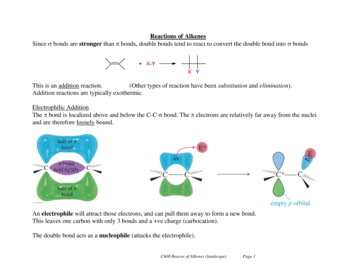
![Radical Healing Syllabus[4] - School of Social Work](/img/36/radical-healing-syllabus-2.jpg)

